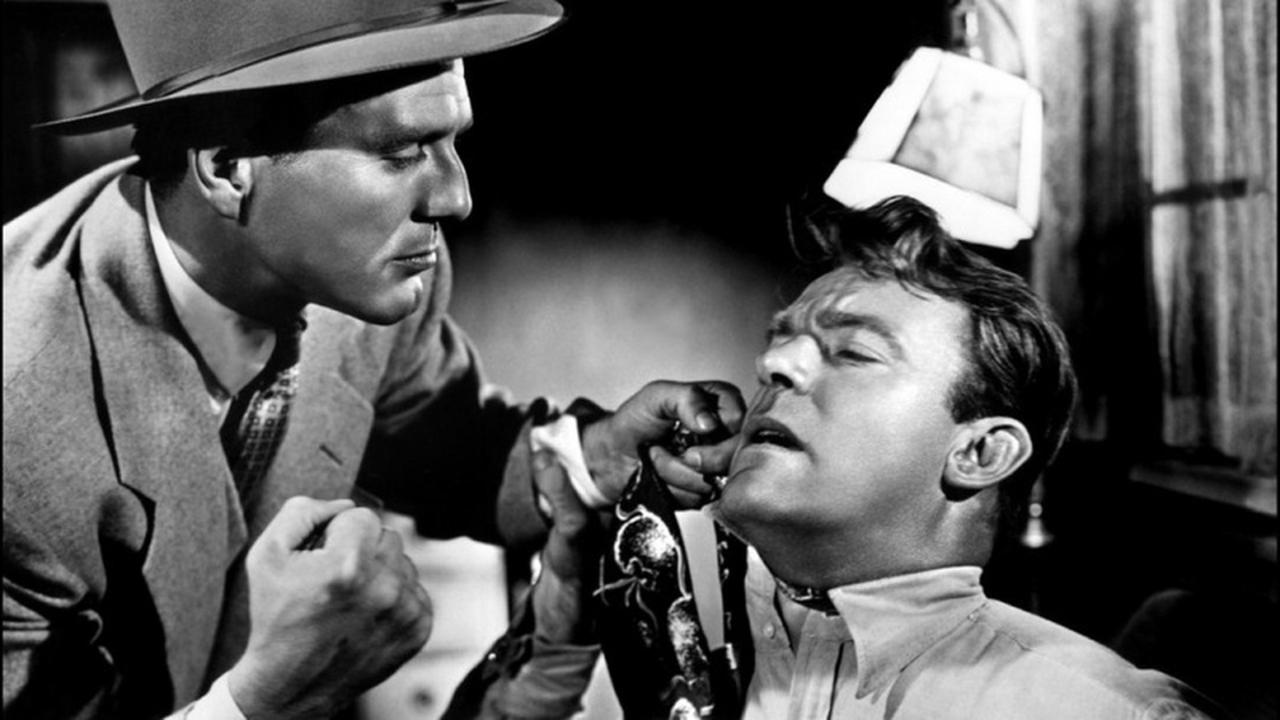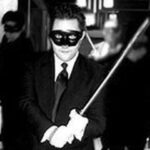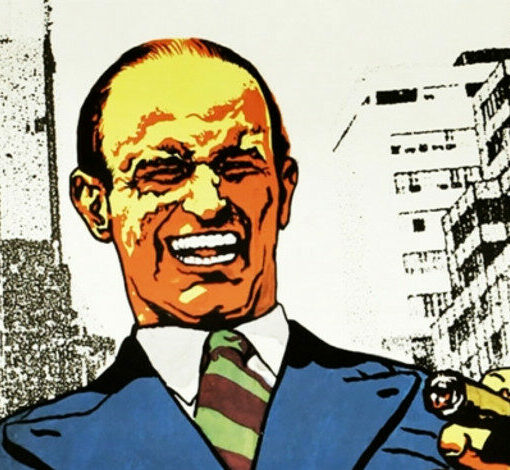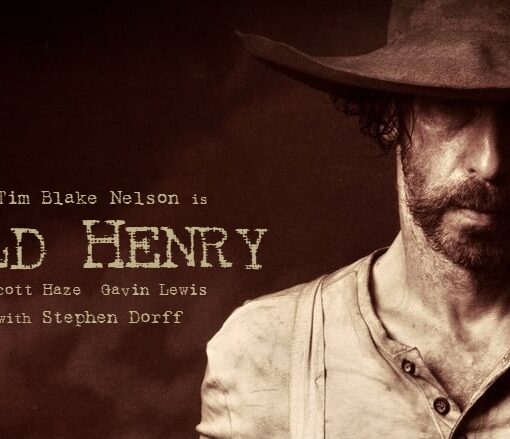In Anthony Mann’s semi-documentary, procedural film noir T-Men (1947) we get a first hand account of how the U.S. Treasury Department operates with a tale referred to as the “Shanghai Paper Case” (based on true events). Following a brief introduction to the background of the Treasury, the story begins with an undercover T-man set to meet an informant named Shorty in connection with a counterfeiting ring but before it occurs, Shorty is shot by a mysterious gunman and robbed of his evidence. The police are alerted about the incident and the Secret Service are immediately put into action. The rapidly edited opening sequence is our first look at Cinematographer John Alton’s lighting compositions which clearly elevate the film from being just another B-crime picture.
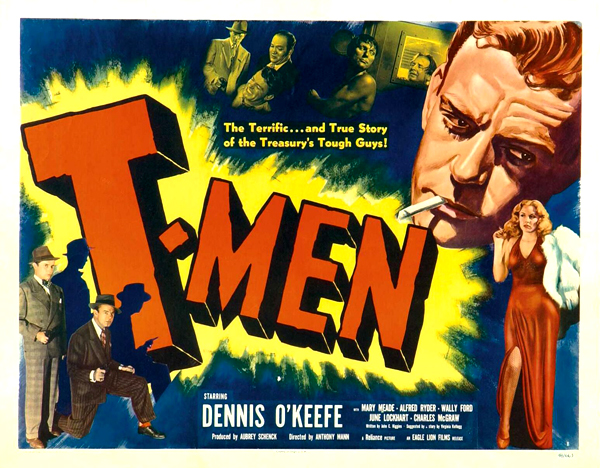 The Treasury department finds out that the counterfeit organization is one of the best in the country, a real “tough, tight outfit”. The Al Capone case is also mentioned (the same one led by real life Treasury agent and Untouchable Elliot Ness) and is an influence on how this case against the ring will be set up and executed. The main lead the department has is the Detroit based Vantucci Mob and two undercover agents are sent in to infiltrate the family. They are Dennis O’Brien (Dennis O’Keefe) and Anthony Genaro (Alfred Ryder) chosen specifically for their unique backgrounds.
The Treasury department finds out that the counterfeit organization is one of the best in the country, a real “tough, tight outfit”. The Al Capone case is also mentioned (the same one led by real life Treasury agent and Untouchable Elliot Ness) and is an influence on how this case against the ring will be set up and executed. The main lead the department has is the Detroit based Vantucci Mob and two undercover agents are sent in to infiltrate the family. They are Dennis O’Brien (Dennis O’Keefe) and Anthony Genaro (Alfred Ryder) chosen specifically for their unique backgrounds.
Once in Detroit, O’Brien and Genaro familiarize themselves with the city and gather facts and information on the mob so they’ll appear to be long time residents of the area. The men set up a backstory and choose a defunct outfit “The River Gang” as their crime affiliation. After quizzing each other to make sure their stories and facts are kosher they set up a meeting with the Vantuccis. They also move into The Forenzi Hotel, a known hangout for criminals. Soon a detective arrives inquiring about the two men to give the idea that they’re wanted by the cops. The hotel owner Pasquale an old hand at these matters doesn’t give them up and the guys make like they’re really on the lam to seem like the true blue criminals.
 O’Brien and Genaro finally meet with the head of the mob Mr. Vantucci at a warehouse where they are introduced under their new mob names: Tony Galvani and Vannie Harrigan, only it’s not by them but from records Vantucci had acquired earlier. They’re welcomed in and given jobs at the bottom rung in Vantucci’s liquor racket then immediately begin snooping away for leads. They soon get one in the form of a Vantucci contact nicknamed “The Schemer” (Wally Ford) who is based out of Los Angeles. O’Brien goes to L.A. to try to find The Schemer using some personal clues: he’s a stout man, an avid cigar smoker and has a preference for chewing Chinese health herbs.
O’Brien and Genaro finally meet with the head of the mob Mr. Vantucci at a warehouse where they are introduced under their new mob names: Tony Galvani and Vannie Harrigan, only it’s not by them but from records Vantucci had acquired earlier. They’re welcomed in and given jobs at the bottom rung in Vantucci’s liquor racket then immediately begin snooping away for leads. They soon get one in the form of a Vantucci contact nicknamed “The Schemer” (Wally Ford) who is based out of Los Angeles. O’Brien goes to L.A. to try to find The Schemer using some personal clues: he’s a stout man, an avid cigar smoker and has a preference for chewing Chinese health herbs.
O’Brien is pointed to a potential spot to look for The Schemer: the cities’ steam baths that he’s known to frequent. As O’Brien investigates every one of them (losing weight in the process) John Alton photographs the setting with an attention placed on the effect the steam has the light and shadows. O’Brien finds The Schemer then trails him to learn his habits around town. He also manages to get into a secret poker game where The Schemer is playing and passes some fake dough to him, but Schemer rats on him and the other guys throw him out. O’Brien pays a visit to The Schemer’s pad in character as Vannie out for revenge for telling on him but calms down and shows him some of the counterfeit cash he’s got. The Schemer is impressed by the work and decides to set up a business deal with Vannie/O’Brien. Meanwhile, O’Brien trails Schemer to the swanky Club Trinidad where he meets a pretty waitress Evangeline (Mary Meade), who turns out to be The Schemer’s contact for the fake loot. After she meets with her secret cohort, a photography lab tech, the two decide that O’Brien could be undercover and they send a thug named Moxie and his sidekick to interrogate him. After they check him out and he comes up clean, they bring him to their boss, a wealthy businessman Shiv Triano (John Wengraf) who is interested in doing a deal and contacts Vantucci to make sure O’Brien/Vannie is ok.
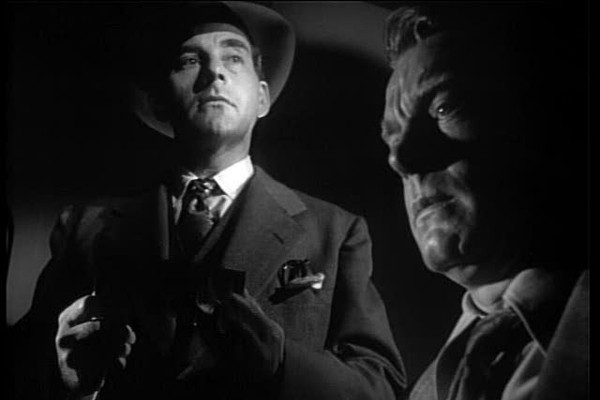 With Vantucci’s word things are on the level, Shiv introduces O’Brien to Paul Miller, the same photography lab technician Evangeline knows who is their counterfeit print expert. Following the successful initial meeting, O’Brien sends in a sample of Miller’s fake money in to the U.S. Treasury Dept for examination. The lab discovers the paper originates in China and they begin checking shipments coming into the country. O’Brien is later introduced to the second head of the counterfeit operation in L.A. who isn’t a tough mobster but an attractive businesswoman named Ms. Simpson (Jane Randolph) and a perfect front.
With Vantucci’s word things are on the level, Shiv introduces O’Brien to Paul Miller, the same photography lab technician Evangeline knows who is their counterfeit print expert. Following the successful initial meeting, O’Brien sends in a sample of Miller’s fake money in to the U.S. Treasury Dept for examination. The lab discovers the paper originates in China and they begin checking shipments coming into the country. O’Brien is later introduced to the second head of the counterfeit operation in L.A. who isn’t a tough mobster but an attractive businesswoman named Ms. Simpson (Jane Randolph) and a perfect front.
While out on the town, The Schemer and Genaro (who has joined O’Brien in L.A.) accidentally run into Genaro’s estranged wife (June Lockhart) and her friend. While Genaro tries to pass it off as mistaken identity, The Schemer can see it’s the real deal from both their reactions. Shiv suspects The Schemer is a potential informant and he sends Moxie to get rid of him, choosing the steam bath to do it at. While pleading with Moxie, The Schemer lets him know about Genaro and his real identity as an undercover agent. We get another mesmerizing sequence of Alton’s unique lighting and shadowplay as Moxie confronts The Schemer in the steam room. When Shiv later gets word from Moxie abut Genaro being a potential rat, he, O’Brien and Moxie pay him a visit. O’Brien knows he can’t give himself up and watches in horror as Genaro is shot right in front of his eyes. This is the final incident which begins a quick unraveling of the operation that has O’Brien holding on by a thin thread as his backup agents zoom in to bust up the counterfeit racket and keep him from being killed.
T-Men is a crackerjack crime film with some of the most inventive use of camera set ups and photography from the noir canon thanks to the combined vision of Anthony Mann and his DP John Alton. The various low angle shots and particularly the scenes filmed in the steam baths bring to mind Gregg Toland’s groundbreaking photography in Citizen Kane (1941) making it a visually stylized cinematic exercise to match up with the twists and turns of the intriguing storyline focused on undercover agents and underworld criminals.
This film was produced by Eagle-Lion Films, a British film production company owned by J. Arthur Rank intended to release British productions in the United States. In 1947 it acquired Robert R. Young’s PRC Pictures, a small American production company, to produce B Pictures to accompany the British releases. The studio became one of the most respected makers of B-movies on what was known as Hollywood’s “Poverty Row.” [1]
Director Anthony Mann began his career with film noir entries such as this film followed by Raw Deal (1948), Border Incident (1948) and Side Street (1950). He went on to make a series of amazing westerns including Winchester 73 (1950), The Naked Spur (1953) and The Man From Laramie (1955) among others. He is now considered one of the most well respected genre auteurs of his era alongside fellow western directors like John Ford, Howard Hawks and Budd Boetticher.
T-Men was nominated for an Academy Award for Best Sound and later featured in Visions of Light: The Art of Cinematography (1992) for the ambitious work by DP John Alton. It was also included in Martin Scorsese’s seminal TCM documentary A Personal Journey Through American Movies (TV, 1995) as a standout work of classic film noir.
References
[1] – Eagle-Lion Films Wiki page
We highly recommend the work of Anthony Mann

